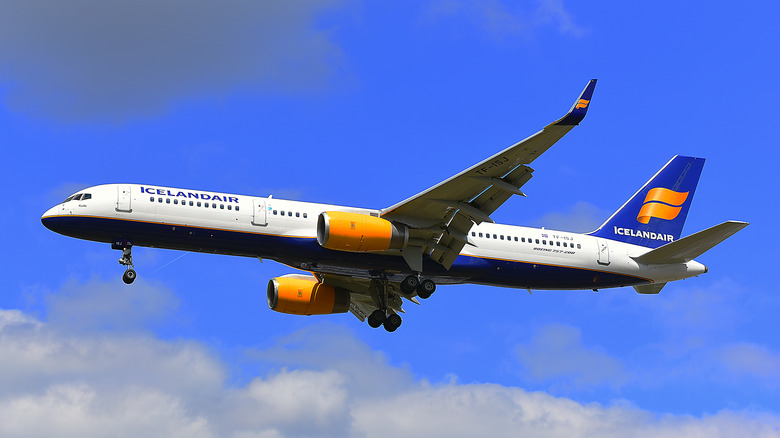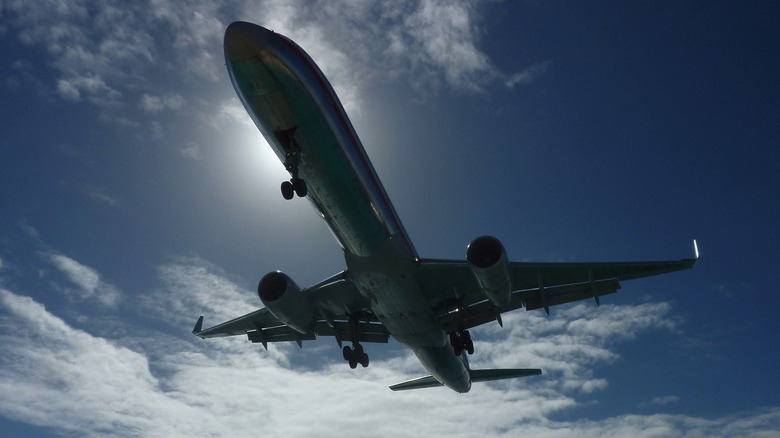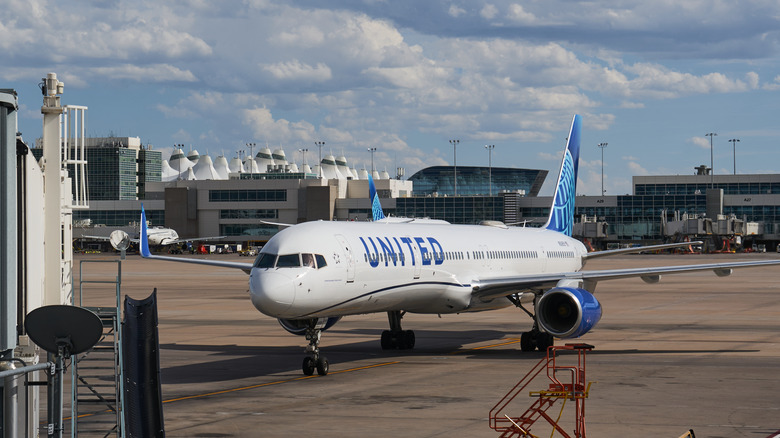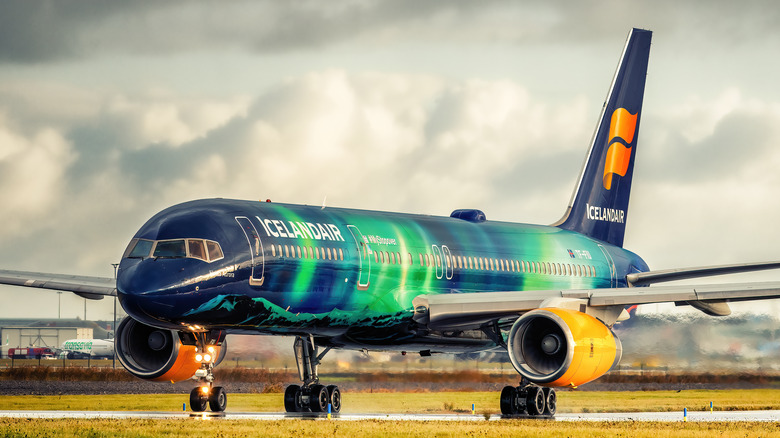Everything To Know About The Boeing 757 Jet
Bill Boeing's lofty place in aviation history is undeniable. The Boeing Company was founded in 1916 in Seattle and would become an industry heavyweight. Fast forward a century or so, and its influence is clear to see, with over 10,000 jetliners bearing its name traveling the world today.
Of course, it's not just about commercial passenger airliners. Boeing has also developed some formidable military aircraft, with the enormous B-29 Superfortress, a World War II bomber (all 105,000 lbs in gross weight of it), just one example of the company's achievements. Nonetheless, it's in the commercial arena that most travelers and pilots will have experienced a Boeing. The venerable 757 is among the company's best-known models of all.
Aviation enthusiasts will surely appreciate this in-depth look at that famous jet, incorporating an introduction to the wider Boeing 700 family, the specs of the 757 (and how they evolved as later variants were introduced), and the impact it had.
A brief introduction to the Boeing 757's predecessors
The company's unique naming convention began with the 707, the result of Boeing's work in the 1950s to develop a jetliner that could both serve the supportive military capacity of refueling other aircraft and prove profitable in a transport capacity. The model boasted four Pratt & Whitney JT3D turbofans, allowing it to travel over 600 mph and carry over 150 people (with crew and passengers included).
In 1955, Pan American World Airways expressed its interest to the tune of 20 orders, while, a year prior, the KC-135, an adaptation of the model for military use, was also ordered. Though the 707 proved popular from the start, it had to fight to remain so. In the interest of doing just that, the 727 was introduced in 1963. It had three Pratt & Whitney engines (the JT8D-1 in this case) rather than four and a comparable top speed to the earlier model but was intended to cement the 700 jets' intent to be practical, relatively inexpensive, and versatile flyers. The 727 was a sleeker model that was great at serving smaller airports.
The Boeing 737 was a successful single-aisle aircraft that took initial flight in 1967, and the mighty 747 jumbo jet of the same era was indicative of an effort to broaden the scope of airliner flight. It would be followed by Boeing's 757 jet, a model that successfully blended several of the family's traits.
The creation of the Boeing 757
The successor to the famed 747 jumbo jet certainly had jumbo shoes to fill. Lynn Rippelmeyer, who was a flight attendant in the 1970s, is quoted by The Guardian as saying that the 747 was "the aeroplane that all the pilots wanted to fly. Because of its size, it's so stable and you just feel so secure in it." The task ahead of Boeing, then, was creating a worthy new addition to the Boeing 700 extended family.
As with the 737 before it, the 757 was created as a single-aisle aircraft with rather more modest dimensions than the jumbo 747 (the 747-400 was around 230 feet long, and the 757-200 measured just over 155 feet). The 757, which made its debut in 1982, used the virtues of the 727's narrow body while implementing more contemporary elements from the creation of the 767, which was in progress during the same period.
To address the noisy engine issue of the 727, the prototype 757 (dubbed the 7N7) would boast its own uniquely designed body, featuring a swept wing approach and a body long enough to carry 239 passengers (in the case of the 757-200). This high maximum passenger capacity for a narrow body, combined with a powerful engine, made the 757 an impressive airplane for its type.
The specs of the Boeing 757
With any vehicle, it's easy to conclude that a bigger and more imposing model would be more powerful than a smaller one. These modest packages, however, can sometimes hide something rather special. The Boeing 757's engines, positioned beneath the wings, were RB211-535Cs from Rolls-Royce on the family's introduction, but it would also be powered by several different varieties from Pratt & Whitney as the 757-300 joined the line: the PW2037, PW2040, and PW2043.
The 757-200 boasted a range of around 4,490 miles (3,900 miles for the 757-300) and had top speeds of approximately 600 mph. With a maximum of 43,500lb of thrust output (provided by the RB211-535E4B), the 757 family had remarkable power for an aircraft of its type. Such power, in fact, means it needs only as little as 6,000 feet to get itself airborne. Versatility was a priority with this aircraft family, and this is a huge part of how that was achieved.
The 757-200 debuted in commercial flight in 1983, serving Eastern Airlines. In contrast to some aircraft models, there wouldn't be a long string of variants following in its wake, but the 757 family did grow as time went on.
Boeing 757 variants
The 757 family, as we've seen, had options that larger aircraft did not. Being able to land where larger relatives and rivals could not opened up other avenues. The 757-200F was designed for a different purpose: Transporting freight. The 200F sported a forward and an aft cargo bay, with load capacities of 10,300 lb and 16,300 lb, respectively.
After this variant came the 757-300, which took the family's single-aisle leanings to new extremes. At around 178.5 feet long, it's an elongated version of the original model, further emphasizing the idea that a more modest aircraft body doesn't necessarily have to sacrifice power or storage. In fact, the 300 can carry more than 50 more passengers compared to the 200.
Though these iterations of the model were developed, they weren't very widely adopted. Only 62 of the 757-300 saw manufacture. Most 757s in use, then, were 200s, the original completed design. That particular model seemed to embody everything about a single-aisle aircraft while offering some additional features that gave it the boost it needed to last. Innovations such as the supercritical wings (a design with a flatter top and rounded bottom) made it an efficient, cost-effective jet with impressive performance. Only the iconic Concorde topped it in terms of the thrust it was capable of as a lighter aircraft.
The Boeing 757 family's continued use
What is it that keeps an older vehicle of any sort in continued use? Certain models do retain a nostalgic appeal that keeps them popular, but there's something simpler than that: Perhaps they simply worked well and continue to. This has certainly proven to be the case with the 757.
The family stopped being manufactured in 2004, over two decades after the first model arrived. Approximately 1,050 of them had been made over this time, and they would make remarkable journeys all over the globe: The Royal New Zealand Air Force arranged a fact-finding flight to Antarctica in a 757 in 2009. In 2015, a special 757, the ecoDemonstrator, was used by NASA to perform a range of flight tests to further research into planet-friendly approaches to fuels.
In 2019, Sam Weigel reported in Flying Magazine that around two-thirds of the 757 fleet manufactured are still being flown. Why had technology not left them behind? As Weigel puts it, the aircraft can "make a 2,200 nm transcontinental flight... with an alternate a few hundred miles away and ample reserves, haul an absolutely full load of passengers and cargo, and still take off from a 7000-foot runway and climb straight into the mid-30s." In short, the 757 boasted and continues to boast a unique combination of traits that has made it an icon of Boeing's repertoire.





